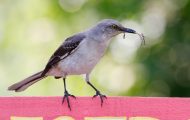There are products out there ready for you to install to drive the birds away. But for some, this isn’t always the best option. I’m sure at some point of your life you loved doing DIY stuff at home. It’s an excellent time-killer plus you get to produce something functional. This can also be the case for driving the birds away using a homemade bird repellent. But the question is, are these worth it or effective, to say the least?
By simply searching the internet, you’ll see dozens of tips and steps on how to come up with your own “recipe”. However, not all of these will turn out effective. There are two reasons for this: first, you’re using it on the wrong bird, or second, it’s a plain scam. The latter is what we’ll avoid on this post. I’ll give you some DIY fowl repellents that work even if you don’t buy the commercial options.
But before we proceed, I want you to place your expectations at a bare minimum. Homemade repellents may not have the same quality and efficiency than the products you can find online. Just give this a try and see if it will work its magic for you.
A few points before we grab the materials:
Before I drop the DIY steps, let me give you some pros and cons of sticking to DIY methods. Of course, it works at some point, but it’s important for you to weigh the two sides. A homemade bird repellent is like any other solutions that have its share of downsides. Here are some of the following pros and cons:

PROS:
Eco-friendly
There’s no doubt that most homemade repellent for fowls would be eco-friendly. This is due to the fact that you’re going to recycle used stuff from your home. Just make sure that you won’t use any harmful chemicals in the process that will defeat this advantage.
Cheap
Some repellent products tend to be pricey, with some ranging from $50 to $100 per set. If you don’t have money for this, DIY methods will save you a hefty amount of money. You just have to utilize what’s available at your home to start sending the birds away from your property.
Handy
With the materials already present in your home, you can make a bird repeller as soon as you plan it. Some kitchen staples, used nails and wood, plywood, and more stuff can turn into effective methods. You just have to look for the things that you can turn into something useful.
Creative
If you’re a bit artsy, you can exploit your time of doing a homemade bird repellent as part of your leisure. You also get to rack your mind how you can improve the performance of your DIY solutions via trial and error.
CONS:
Entails a lot of work
If you want to save money, you need to have your hands do the dirty work. Do you want a makeshift bird spike? You better start hammering some nails and deal with old wood. It requires effort which is just the right bargain for saving yourself from the expenses.
No guarantees
The moment you created a bird deterrent, it has no guarantee that it will work. You might fail and have nothing to be answerable but you. Unlike buying commercial options, you can send the product back and have your money refunded. That is if you have the budget. At this point, trial and error could be a tiresome task.
Can be an eyesore
Let’s face it. Some DIY products aren’t really that good looking. If you’re conscious about how your property looks, you’ll find your homemade bird repellent a bit of an eyesore or discomfort. The homemade bird deterrent spray is one example.
May not target a lot of birds
This may happen even on commercial products out there, but the difference is you have the guarantee. The DIY product you just made may not work its magic on some bird species the way its commercial version does.
HOMEMADE BIRD REPELLENT SOLUTIONS THAT YOU CAN USE
After knowing what you’ll face by using the following DIY solutions, I’ll give you some tried and tested samples for you to practice. Take note that this may or may not work for you depending on the extent of the invasion and the birds you’re planning to get rid of.
Homemade Spray Repellent
Birds who peck on your vegetable garden are your mortal enemies. They don’t just kill your plants, they also make a big mess on your yard that you’ll be tasked to clean. At this point, you need a spray that won’t kill your plants but has the ability to send the birds flying away.
To make this homemade bird repellent, you need to get a few things from your kitchen:
-chili pepper
-transparent empty bottle
-knife
-water
-vinegar
-spray bottle

The first step is to chop the chili peppers thinly. Be careful in doing this as the juice from the pepper will sting so badly in the skin (God forbid it squirts into your eyes). You can also crush the peppers instead.
After that, half fill the empty bottle with water. You can use an empty soda bottle as long as it’s transparent. This part will become clear in the succeeding steps.
Mix the chili into the water and shake it well. Let this bottled mixture sit under direct sunlight for five days to ferment (that’s why the bottle has to be transparent). After the long fermentation process, add ¼ cup of vinegar into it and shake it well. Put some of the mixture on your spray bottle and you’re good to go. The odor would be too strong for the birds.
Makeshift bird spikes
Does a flock of birds keep on perching on your fence? If the pesky fowls keep on leaving their gross droppings, it’s pressing that you install some bird spikes to encourage them from landing on it again. You can purchase commercial bird spikes, but in case you don’t have the extra, you can make your own at the comfort of your garage.
To do this homemade bird repellent, here are some materials that you’ll need:
-used or new long nails (totally up to you)
-a piece of wooden beam (used or new, up to you)
-hammer/drill (whatever suits you)
First, get your wooden beam and nails. All you have to do is to hammer or drill them until the sharp end passes through. It’s important that you use nails twice as long as the thickness of the wooden beam. You can do it in a plain upward position or mimic the alignment of the commercial spikes.
After that, nail the now nail-dotted wooden beam on top of your fence or roof ledge. This may look ugly but it will solve your problem for a long time. The only downside is that the nails can rust and add up to the eyesore.
Plywood slope
If the problem is the birds nesting on your gutter, you need to come up with a deterrent that will make the spot unpleasant for landing or nesting. The V-shaped shade at the edge of your roof window has become an easy target for nesting. This wouldn’t be a problem if the birds won’t leave droppings and debris that can damage the roof tiles.h
Before doing the steps for the next homemade bird repellent, remember that it can be illegal to tamper the already present nest of a bird. You will have to call a professional wildlife remover for the nest to be relocated.
For the slope, you only need a few things:
-plywood or PVC offcut
-saw
-silicone glue
-tape measure or anything that you can use to get the right sizing
Using your tape measure, check the distance between the highest and lowest point of eaves’ or window’s recess. From there, you can now cut the size from the plywood or PVC material you have. Once you have the right size, climb up the roof and install the plank in at least 45-degree inclination. Use the silicone glue on the surface of the roof tile to fix the plank in place.
After that, no birds will dare nest because of the slope you just installed.
DIY reflectors (CDs)
In the previous posts I shared here with you, I’m sure that you’ve learned about how shiny and reflective surfaces can halt the birds on its track. Most of the time, I gave commercial solutions for you to utilize. As days pass by, I realized that not everyone may have the budget to purchase the products right away. This is where a DIY or homemade bird repellent will come in handy.

Some things to get you started:
-old CDs (new, if you hate that latest album you just bought)
-small mirror
-microfilament strings
-scissors
-hooks (optional)
With the CDs in hand, make sure that its iridescent surface is present and can reflect a large amount of light. Tie the CDs using the microfilament strings (it’s the one used for fishing lines) in two layers, with the iridescent surfaces exposed. As simple as that, you have a flash scare. Tie it on the trees pestered by birds or some other parts of your property. You can utilize the hooks if it’s impossible to tie the strings.
Another option is to use the small mirror you have the same way you’ll hang the CDs. It’s a powerful reflector and it’s not prone to “catch lightning” like what the old folks believe.
Suet feeder
Woodpeckers are very nasty birds. They would drum on your wood sidings and trees until they bore holes and incur further damages. The birds do this for nesting, feeding, and communication, which isn’t really pleasant for someone who has to deal with the damages afterward.
This is where you can utilize a suet feeder as a homemade bird repellent. Take note, however, that you should only utilize this feeder during the colder months when the beef fat will stay solid. Molten suet feeder will stick to the bird’s feathers and possibly kill them in the process. Woodpeckers are protected species and casualties are the last thing you would want to happen.
To create the suet feeder, you will need the following materials:
-beef fat
-bird seeds
-molding container
-saucepan
-microwave/gas stove

Let the beef fat melt in the saucepan. Once you have the fats in liquid form, dump some bird seeds on it. Let this mixture solidify in a cake-like structure on the molding container. Put this on a cage or another container that you’ll then place away from your property. It’s a diversion tactic so the birds will find another food source to devour. Not your vegetable bed or the sappy tree you have in your yard.
Placing more than one of this homemade bird repellent in the surrounding areas of your house is a good option.
Warning shots
For a large flock of crows that are aggressive enough to ignore your other homemade tactics, a blank shot from a starting pistol would be ideal. The loud sound will send the blackbirds flying away. If you do this consistently, they will be leaving you alone. However, it’s important that you pair it with other methods, just in case you meet the nastiest bird in town.
The only downside to using blank shots is your neighbors might be alarmed too. It’s important that you let them know first before firing that shot. You don’t want to end up with someone calling 911. In case you don’t have the gun, you can use pans to create a ruckus.
Are you planning to make your own homemade bird repellent? The examples I listed above are just some of the possible solutions you can try. All these are tried and tested but it depends on your situation if it will work well. Do you have something to add? Let us know below in the comment section!



